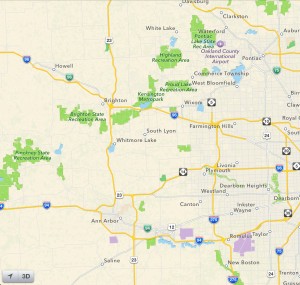Apple Inc. (NASDAQ:AAPL) has taken considerable flak over the years for its Apple Maps application, which has shown a number of flaws both small and large. Mislabeled addresses, roads with no names, displacement of actual features from where they should truly be indicated, and similar problems have caused much angst and complaint from iPhone users and other users of Apple devices. Understanding why these problems exist is key to answering the intriguing question of whether the release of iOS 8 will really fix the mapping software’s problems.
The original mapping app included with the first-generation iPhone in 2007 was Google Maps. Google’s mapping service was also quite “rough around the edges” for a long time, but was sleek and polished by the time that it appeared on the first, iconic iPhone. At that point, all the headaches of compiling and curating the stupendous amount of data that goes into an accurate global mapping service had already been done by Google.
 With access to Google Maps, Apple Inc. (AAPL) had no motivation to “reinvent the wheel” and undertake the huge project on their own. Instead, the firm leaned on an experienced partner and concentrated on its own area of expertise.
With access to Google Maps, Apple Inc. (AAPL) had no motivation to “reinvent the wheel” and undertake the huge project on their own. Instead, the firm leaned on an experienced partner and concentrated on its own area of expertise.
The Break with Google and the Rise of Apple Maps
Apple Inc. (AAPL) eventually fell out with Google and canceled its use of Google Maps in 2012, with the arrival of iOS 6. The dispute was caused by decisions on both sides, but came to a head because of Google’s release of Android. Google refused to provide Apple with turn-by-turn navigation, wishing to reserve this feature for its own use. Apple, in turn, recognized that it was being left with a second-rate product, and decided to cut its losses and strike out on its own.
Of course, this led to gigantic problems. A fully functional mapping service for the entire globe is nearly impossible to build from the ground up in a matter of months, but Apple undertook the challenge because it needed some sort of mapping services app for the iOS 6. Apple Maps, in short, was a stopgap, emergency feature cobbled together out of the mapping programs of several smaller companies. Considering that it was more or less a piece of duct tape over a sucking chest wound, the app was probably surprisingly effective.
Apple Maps was plagued with multiple issues, including the fact that map accuracy was low for mapped locations outside North America. Ultimately, Tim Cook apologized publicly for the appalling problems that cropped up for many users, and fired Scott Forstall, who was held responsible for the mess. Due to the company’s policy of secrecy, it is unclear how much Mr. Forstall was to blame for the problems, and how much he was scapegoated after being handed a nearly impossible task.
Regardless, it is now claimed that iOS 8 will witness major improvements to Apple Maps, including a high degree of informational accuracy (crucial to the utility of any mapping service) and the addition of public transport route information, a first for the iPhone app. The question, of course, is whether Apple Inc. (AAPL) is really capable of delivering improved maps.
The history of Apple Maps suggests that the product has been flawed not because Apple is somehow incapable of producing a good mapping app, but because it was forced to rush out a product it originally had no intention of making to cover a sudden functionality gap. Mapping software is a huge, complex undertaking and it takes time to construct a proprietary map database with full accuracy for all global locations. The odds are in favor of major improvements to Apple Maps in iOS 8, simply because Apple’s programmers have had more time to work on the product and a number of acquisitions the company made recently may also boost its success at mapping.



